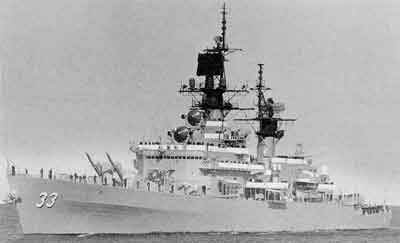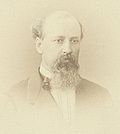 |
History of theUSS Fox DLG/CG-33 |
|||||||||||||||||||||||||||||||||||||||
|
The USS Fox (DLG-33) was a Belknap -class cruiser of the United States Navy, named after Gustavus V. Fox , President Abraham Lincoln 's Assistant Secretary of the Navy. The keel for DLG-33 was authenticated and laid in ceremonies at Todd Shipyards Corporation, San Pedro, California on 15 January 1963.
RADM Frank Virden, then Commander Cruiser-Destroyer Force, US Pacific Fleet , presided over the ceremonies for the unnamed ship. Christening and launching ceremonies were performed at on 21 November 1964. Fox entered naval service as a Guided Missile Frigate (DLG) on 28 May 1966 when commissioned at Long Beach Naval Shipyard under the guidance of her first commanding officer, CAPT Robert O. Welander. Fox subsequently transited to her homeport of San Diego on 6 October 1966 and become the first ship in the Pacific Fleet capable of launching both anti-submarine rockets (ASROC) and surface-to-air guided missiles from the same launching system. The U.S.S. Fox, as DLG-33, wasted no time distinguishing herself. Participating in support of the large scale troop build up in Vietnam, and consequent increase in aircraft operations, her technology at the time was formidable. Her actions not only included support to the Vietnam conflict shore operations in the Western Pacific but she did so at her primary duty station off the coast of North Vietnam as the northern search and rescue ship controlling carrier-launched combat aircraft at PIRAZ . On a normal day, Fox monitored the activity of 200 Navy and Air Force missions. In particular, on 23 October 1967, a Fox air controller directed two F-4 fighters from the carrier USS Constellation to intercept the subsequent kill of a North Vietnamese MIG-21 aircraft over Hanoi . It was the first time during the Vietnam War a shipboard controller had directed an intercept which resulted in a shoot-down of enemy aircraft. For such gallantry, Fox was awarded the Meritorious Unit Commendation graciously accepted by her then CO: Captain R.O. Whelander. During this intense period her communications staff, under the leadership of RMCS Haber, was so well trained that they were able to maintain an entire flotilla's radio traffic without losing a message. During her 1968 deployment, her communications officer (OC Division head) was LT. Robert Woodward. Woodward would later work for the Washington Post and teamed with Burnstein investigated the now infamous Watergate Office break-in which led to President Richard Nixon's resignation. These early years continued to be highlighted by exemplary performance and poise. Of particular note in 1972, Fox was the at-sea platform in support of CNO Project DV-98 LAMPS. Such prowess garnered Fox the enviable distinction and award of an Operations Department Efficiency GOLD "E" for five straight years of operational readiness. Fox was originally classified as a guided missile frigate along with her sister ships: USS Josephus Daniels , USS Wainwright , USS Jouett , USS Horne , USS Sterett , USS William H. Standley and USS Biddle . They were funded by Congress during FY61 and FY62 as "Belknap Class" combatants at a time when "cruiser" nomenclature was forbidden. Designed as a "single-ended" guided missile platform built to screen aircraft carriers and provide combat air support. The USS Belknap was severely damaged in a collision with the carrier USS John F. Kennedy (CV-67) in the Ionian Sea on 22 November 1975. In the interim, on 30 June 1975, Fox , along with her sister ships in the "new" Josephus Daniels class, were reclassified as a Guided Missile Cruiser (CG). Original armament included anti-submarine (ASROC) and anti-air (TERRIER) guided missiles. Such systems could automatically locate, track and engage the enemy at extremely long ranges. In addition to a 5 inch / 54 caliber gun and two MK32 torpedo launchers; AN/SQS-26 sonar; AN/SPS-48 three-dementional radar; AN/SPS-40 two-dimensional radar; NTDS (later CDS) computer processing and dissemination of tactical information data systems, other equipments were added including quad-canister HARPOON surface to surface missile launchers and Vulcan Phalanx Close In Weapons System. During her final shipyard overhaul in 1989, Fox received the New Threat Upgrade (NTU) combat system which significantly enhanced her already impressive warfighting potential. Fox' s first visit to the Red Sea was in March 1976. Her first deployment to the Persian Gulf took place in November 1980. Her accomplishments and credits are lengthy and worthy. The Iran-lraq conflicts of the 1980s made it necessary for Fox to escort U.S. flagged oil tankers through such areas as the Straits of Hormuz of the Arabian Sea. Her deployment during 1987 included this mission which earned Fox her second Meritorious Unit Commendation. In a 1993 transit of the Strait of Hormuz, Fox was approached by a ship from the Iranian coast. The ship was identified as an old water tender. It was a hazy day, but several small radar contacts separated from the ship and approached Fox . They were small boats with two individuals in each. They circled Fox and returned to the mother ship. The crew of Fox took no action, in accordance with the rules of engagement. The incident bears some resemblance to the later attack on the USS Cole, and could be construed as a "dress rehearsal". Between 1966 and 1993, Fox had made 15 deployments to areas of conflict. Additional awards for service and valor include three Battle "E" Ribbons, two Navy Expeditionary Medals for services in the Indian Ocean/Persian Gulf, two National Defense Service Medals, the Vietnam Service Medal (with two bronze stars), the Southwest Asia Service Medal (with bronze star), Sea Service Deployment Ribbons and the Republic of Vietnam Campaign Medal. Fox concluded her last overseas cruise near the end of 1993 and immediately began inactivation preparations. Decommissioned in mid-April 1994, she was sold for scrapping in 1995
|
|||||||||||||||||||||||||||||||||||||||
 |
||||||||||||||||||||||||||||||||||||||||
Gustavus Vasa Fox (June 13, 1821–October 29, 1883) was an officer of the United States Navy , who served during the Mexican-American War , and as Assistant Secretary of the Navy during the Civil War . |
||||||||||||||||||||||||||||||||||||||||
| Born at Saugus, Massachusetts , and a student at Phillips Academy , Andover, Massachusetts (1835), Fox was appointed midshipman 12 January 1838. During the Mexican-American War , he served in the brig Washington in the squadron of Commodore Matthew Perry and took active part in the second expedition against Tabasco , Mexico , 14-16 January 1847, which resulted in the capture of that town. He was in command of several mail steamers and after his resignation 30 July 1856, engaged in the manufacture of woolen materials. At the start of the American Civil War he volunteered for service. He was given a temporary appointment in the Navy and was sent in the steamer Baltic to the relief of Major Robert Anderson and the remnant of his command in Fort Sumter , and brought them away.
|
||||||||||||||||||||||||||||||||||||||||
| On 1 August 1861, President Abraham Lincoln appointed him Assistant Secretary of the Navy under Secretary Gideon Welles , an office which he held until the close of the Civil War. In 1866, he was sent on a special mission to Russia and conveyed the congratulations of the President of the United States to Tzar Alexander II upon his escape from assassination. His voyage was made in the monitor Miantonomoh which was the first vessel of this class to cross the Atlantic. They were accompanied by Augusta . In 1882 he published a paper suggesting Samana Cay in the Bahamas to be Guanahani , or San Salvador, the first island Christopher Columbus reached at his discovery of the Americas . Little attention was paid to it until 1986, when the National Geographic Society also appointed Samana Cay to be San Salvador. He died at Lowell, Massachusetts , aged 62. Three ships of the US Navy have been named USS Fox in his memory.
|
||||||||||||||||||||||||||||||||||||||||
Home | Message Board | Commanding Officers | Anchors Aweigh | History | Reunion